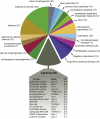Receptor-type guanylate cyclase is required for carbon dioxide sensation by Caenorhabditis elegans
- PMID: 21173231
- PMCID: PMC3017194
- DOI: 10.1073/pnas.1017354108
Receptor-type guanylate cyclase is required for carbon dioxide sensation by Caenorhabditis elegans
Abstract
CO(2) is both a critical regulator of animal physiology and an important sensory cue for many animals for host detection, food location, and mate finding. The free-living soil nematode Caenorhabditis elegans shows CO(2) avoidance behavior, which requires a pair of ciliated sensory neurons, the BAG neurons. Using in vivo calcium imaging, we show that CO(2) specifically activates the BAG neurons and that the CO(2)-sensing function of BAG neurons requires TAX-2/TAX-4 cyclic nucleotide-gated ion channels and the receptor-type guanylate cyclase GCY-9. Our results delineate a molecular pathway for CO(2) sensing and suggest that activation of a receptor-type guanylate cyclase is an evolutionarily conserved mechanism by which animals detect environmental CO(2).
Conflict of interest statement
The authors declare no conflict of interest.
Figures





References
-
- Haas W. Parasitic worms: Strategies of host finding, recognition and invasion. Zoology (Jena) 2003;106:349–364. - PubMed
-
- Guerenstein PG, Hildebrand JG. Roles and effects of environmental carbon dioxide in insect life. Annu Rev Entomol. 2008;53:161–178. - PubMed
-
- Suh GS, et al. A single population of olfactory sensory neurons mediates an innate avoidance behaviour in Drosophila. Nature. 2004;431:854–859. - PubMed
-
- Faucher C, Forstreuter M, Hilker M, de Bruyne M. Behavioral responses of Drosophila to biogenic levels of carbon dioxide depend on life-stage, sex and olfactory context. J Exp Biol. 2006;209:2739–2748. - PubMed
Publication types
MeSH terms
Substances
Associated data
- Actions
- Actions
Grants and funding
LinkOut - more resources
Full Text Sources
Molecular Biology Databases
Research Materials

